# MongoDB 和 GridFS 用于內部和內部數據中心數據復制
> 原文: [http://highscalability.com/blog/2013/1/14/mongodb-and-gridfs-for-inter-and-intra-datacenter-data-repli.html](http://highscalability.com/blog/2013/1/14/mongodb-and-gridfs-for-inter-and-intra-datacenter-data-repli.html)
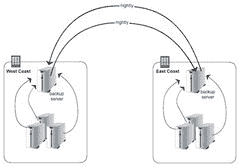 *這是 LogicMonitor 副總裁 [Jeff Behl](jbehl@logicmonitor.com) 的來賓帖子。 [在過去 20 年中,Jeff](@jeffbehl) 有點過時,他為許多基于 SaaS 的公司設計和監督基礎架構。*
## 用于災難恢復的數據復制
災難恢復計劃的必然部分是確保客戶數據存在于多個位置。 對于 LogicMonitor,這是一個基于 SaaS 的物理,虛擬和云環境的監視解決方案,我們希望在數據中心內外都可以復制客戶數據文件。 前者用于防止設施中的單個服務器丟失,而后者用于在數據中心完全丟失的情況下進行恢復。
## 我們在哪里:Rsync
像大多數在 Linux 環境下工作的人一樣,我們使用了可信賴的朋友 rsync 來復制數據。
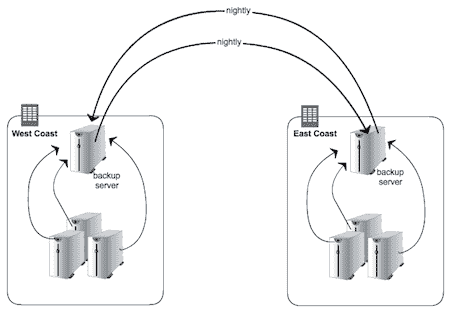
Rsync is tried, true and tested, and works well when the number of servers, the amount of data, and the number of files is not horrendous. ?When any of these are no longer the case, situations arise, and when the number of rsync jobs needed increases to more than a handful, one is inevitably faced with a number of issues:
* 備份作業重疊
* 備份作業時間增加
* 過多的同時作業使服務器或網絡超載
* 完成 rsync 作業后,沒有簡單的方法來協調所需的其他步驟
* 沒有簡便的方法來監視作業計數,作業統計信息并在發生故障時得到警報
Here at LogicMonitor [our philosophy](http://blog.logicmonitor.com/2012/07/17/our-philosophy-of-monitoring/) and reason for being is rooted in the belief that everything in your infrastructure needs to be monitored, so the inability to easily monitor the status of rsync jobs was particularly vexing (and no, we do not believe that emailing job status is monitoring!). ?We needed to get better statistics and alerting, both in order to keep track of backup jobs, but?also to be able to put some logic into the jobs themselves to prevent issues like too many running simultaneously.The obvious solution was to store this information into a database. A database repository for backup job metadata, where jobs themselves can report their status, and where other backup components can get information in order to coordinate tasks such as removing old jobs, was clearly needed. ?It would also enable us to monitor backup job status via simple queries for information such as the number of jobs running (total, and on a per-server basis), the time since the last backup, the size of the backup jobs, etc., etc. ??
## MongoDB 作為備份作業元數據存儲
The type of backup job statistics was more than likely going to evolve over time, so MongoDB came to light with its “[schemaless](http://blog.mongodb.org/post/119945109/why-schemaless)” document store design. ?It seemed the perfect fit: easy to setup, easy to query, schemaless, and a simple JSON style structure for storing job information. ?As an added bonus, MongoDB replication is excellent: ?it is robust and extremely easy to ?implement and maintain. ?Compared to MySQL, adding members to a MongoDB replica set is auto-magic.So the first idea was to keep using rsync, but track the status of jobs in MongoDB. But it was a kludge to have to wrap all sorts of reporting and querying logic in scripts surrounding rsync. ?The backup job metainfo and the actual backed up files were still separate and decoupled, with the metadata in MongoDB and the backed up files residing on a disk on some system (not necessarily the same). ?How nice it would be if the the data and the database were combined. ?If I could query for a specific backup job, then use the same query language again for an actual backed up file and get it. ?If restoring data files was just a simple query away... ?[Enter GridFS](http://docs.mongodb.org/manual/applications/gridfs/).
## 為什么選擇 GridFS
You can read up on the details GridFS on the MongoDB site, but suffice it to say it is a simple file system overlay on top of MongoDB (files are simply chunked up and stored in the same manner that all documents are). ?Instead of having scripts surround rsync, our backup scripts store the data and the metadata at the same time and into the same place, so everything is easily queried.
當然,MongoDB 復制可與 GridFS 一起使用,這意味著備份的文件可立即在數據中心內和異地復制。 通過 Amazon EC2 內部的副本,可以拍攝快照以保留所需的盡可能多的歷史備份。 現在,我們的設置如下所示:
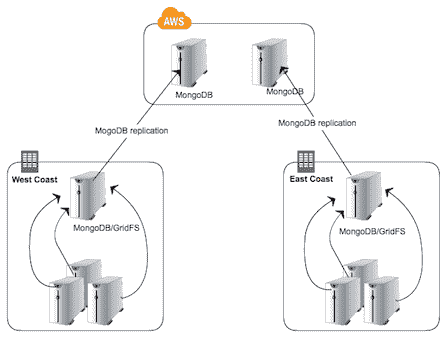
優點
* 作業狀態信息可通過簡單查詢獲得
* 備份作業本身(包括文件)可以通過查詢檢索和刪除
* 復制到異地位置實際上是立即的
* 分片可能
* 借助 EBS 卷,通過快照進行 MongoDB 備份(元數據和實際備份數據)既簡單又無限
* 自動化狀態監控很容易
## 通過 LogicMonitor 進行監控
LogicMonitor 認為,從物理級別到應用程序級別的基礎架構的所有方面都應位于同一監視系統中:UPS,機箱溫度,OS 統計信息,數據庫統計信息,負載平衡器,緩存層,JMX 統計信息,磁盤 寫入延遲等)。所有都應該存在,其中包括備份。 為此,LogicMonitor 不僅可以監視 MongoDB 的常規統計信息和運行狀況,還可以對 MongoDB 執行任意查詢。 這些查詢可以查詢任何內容,從登錄靜態信息到頁面視圖,再到最后一個小時內完成的(猜測是什么?)備份作業。
Now that our backups are all done via MongoDB, I ?can keep track of (and more importantly, be alerted on):
* 每臺服務器運行的備份作業數
* 所有服務器之間同時執行的備份數
* 任何未備份超過 6 個小時的客戶門戶
* MongoDB 復制滯后
### 復制滯后
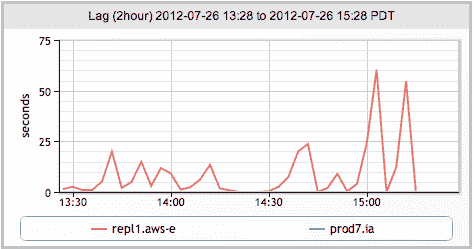
### 工作完成
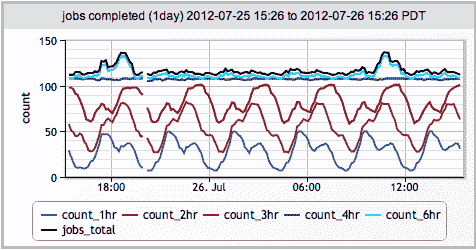
您是否正在使用保險絲訪問 GridFS,或者是否正在根據 API 編寫所有代碼?
- LiveJournal 體系結構
- mixi.jp 體系結構
- 友誼建筑
- FeedBurner 體系結構
- GoogleTalk 架構
- ThemBid 架構
- 使用 Amazon 服務以 100 美元的價格構建無限可擴展的基礎架構
- TypePad 建筑
- 維基媒體架構
- Joost 網絡架構
- 亞馬遜建筑
- Fotolog 擴展成功的秘訣
- 普恩斯的教訓-早期
- 論文:Wikipedia 的站點內部,配置,代碼示例和管理問題
- 擴大早期創業規模
- Feedblendr 架構-使用 EC2 進行擴展
- Slashdot Architecture-互聯網的老人如何學會擴展
- Flickr 架構
- Tailrank 架構-了解如何在整個徽標范圍內跟蹤模因
- Ruby on Rails 如何在 550k 網頁瀏覽中幸存
- Mailinator 架構
- Rackspace 現在如何使用 MapReduce 和 Hadoop 查詢 TB 的數據
- Yandex 架構
- YouTube 架構
- Skype 計劃 PostgreSQL 擴展到 10 億用戶
- 易趣建筑
- FaceStat 的禍根與智慧贏得了勝利
- Flickr 的聯合會:每天進行數十億次查詢
- EVE 在線架構
- Notify.me 體系結構-同步性
- Google 架構
- 第二人生架構-網格
- MySpace 體系結構
- 擴展 Digg 和其他 Web 應用程序
- Digg 建筑
- 在 Amazon EC2 中部署大規模基礎架構的六個經驗教訓
- Wolfram | Alpha 建筑
- 為什么 Facebook,Digg 和 Twitter 很難擴展?
- 全球范圍擴展的 10 個 eBay 秘密
- BuddyPoke 如何使用 Google App Engine 在 Facebook 上擴展
- 《 FarmVille》如何擴展以每月收獲 7500 萬玩家
- Twitter 計劃分析 1000 億條推文
- MySpace 如何與 100 萬個并發用戶一起測試其實時站點
- FarmVille 如何擴展-后續
- Justin.tv 的實時視頻廣播架構
- 策略:緩存 404 在服務器時間上節省了洋蔥 66%
- Poppen.de 建筑
- MocoSpace Architecture-一個月有 30 億個移動頁面瀏覽量
- Sify.com 體系結構-每秒 3900 個請求的門戶
- 每月將 Reddit 打造為 2.7 億頁面瀏覽量時汲取的 7 個教訓
- Playfish 的社交游戲架構-每月有 5000 萬用戶并且不斷增長
- 擴展 BBC iPlayer 的 6 種策略
- Facebook 的新實時消息系統:HBase 每月可存儲 135 億條消息
- Pinboard.in Architecture-付費玩以保持系統小巧
- BankSimple 迷你架構-使用下一代工具鏈
- Riak 的 Bitcask-用于快速鍵/值數據的日志結構哈希表
- Mollom 體系結構-每秒以 100 個請求殺死超過 3.73 億個垃圾郵件
- Wordnik-MongoDB 和 Scala 上每天有 1000 萬個 API 請求
- Node.js 成為堆棧的一部分了嗎? SimpleGeo 說是的。
- 堆棧溢出體系結構更新-現在每月有 9500 萬頁面瀏覽量
- Medialets 體系結構-擊敗艱巨的移動設備數據
- Facebook 的新實時分析系統:HBase 每天處理 200 億個事件
- Microsoft Stack 是否殺死了 MySpace?
- Viddler Architecture-每天嵌入 700 萬個和 1500 Req / Sec 高峰
- Facebook:用于擴展數十億條消息的示例規范架構
- Evernote Architecture-每天有 900 萬用戶和 1.5 億個請求
- TripAdvisor 的短
- TripAdvisor 架構-4,000 萬訪客,200M 動態頁面瀏覽,30TB 數據
- ATMCash 利用虛擬化實現安全性-不變性和還原
- Google+是使用您也可以使用的工具構建的:閉包,Java Servlet,JavaScript,BigTable,Colossus,快速周轉
- 新的文物建筑-每天收集 20 億多個指標
- Peecho Architecture-鞋帶上的可擴展性
- 標記式架構-擴展到 1 億用戶,1000 臺服務器和 50 億個頁面視圖
- 論文:Akamai 網絡-70 個國家/地區的 61,000 臺服務器,1,000 個網絡
- 策略:在 S3 或 GitHub 上運行可擴展,可用且廉價的靜態站點
- Pud 是反堆棧-Windows,CFML,Dropbox,Xeround,JungleDisk,ELB
- 用于擴展 Turntable.fm 和 Labmeeting 的數百萬用戶的 17 種技術
- StackExchange 體系結構更新-平穩運行,Amazon 4x 更昂貴
- DataSift 體系結構:每秒進行 120,000 條推文的實時數據挖掘
- Instagram 架構:1400 萬用戶,1 TB 的照片,數百個實例,數十種技術
- PlentyOfFish 更新-每月 60 億次瀏覽量和 320 億張圖片
- Etsy Saga:從筒倉到開心到一個月的瀏覽量達到數十億
- 數據范圍項目-6PB 存儲,500GBytes / sec 順序 IO,20M IOPS,130TFlops
- 99designs 的設計-數以千萬計的綜合瀏覽量
- Tumblr Architecture-150 億頁面瀏覽量一個月,比 Twitter 更難擴展
- Berkeley DB 體系結構-NoSQL 很酷之前的 NoSQL
- Pixable Architecture-每天對 2000 萬張照片進行爬網,分析和排名
- LinkedIn:使用 Databus 創建低延遲更改數據捕獲系統
- 在 30 分鐘內進行 7 年的 YouTube 可擴展性課程
- YouPorn-每天定位 2 億次觀看
- Instagram 架構更新:Instagram 有何新功能?
- 搜索技術剖析:blekko 的 NoSQL 數據庫
- Pinterest 體系結構更新-1800 萬訪問者,增長 10 倍,擁有 12 名員工,410 TB 數據
- 搜索技術剖析:使用組合器爬行
- iDoneThis-從頭開始擴展基于電子郵件的應用程序
- StubHub 體系結構:全球最大的票務市場背后的驚人復雜性
- FictionPress:在網絡上發布 600 萬本小說
- Cinchcast 體系結構-每天產生 1,500 小時的音頻
- 棱柱架構-使用社交網絡上的機器學習來弄清您應該在網絡上閱讀的內容
- 棱鏡更新:基于文檔和用戶的機器學習
- Zoosk-實時通信背后的工程
- WordPress.com 使用 NGINX 服務 70,000 req / sec 和超過 15 Gbit / sec 的流量
- 史詩般的 TripAdvisor 更新:為什么不在云上運行? 盛大的實驗
- UltraDNS 如何處理數十萬個區域和數千萬條記錄
- 更簡單,更便宜,更快:Playtomic 從.NET 遷移到 Node 和 Heroku
- Spanner-關于程序員使用 NoSQL 規模的 SQL 語義構建應用程序
- BigData 使用 Erlang,C 和 Lisp 對抗移動數據海嘯
- 分析數十億筆信用卡交易并在云中提供低延遲的見解
- MongoDB 和 GridFS 用于內部和內部數據中心數據復制
- 每天處理 1 億個像素-少量競爭會導致大規模問題
- DuckDuckGo 體系結構-每天進行 100 萬次深度搜索并不斷增長
- SongPop 在 GAE 上可擴展至 100 萬活躍用戶,表明 PaaS 未通過
- Iron.io 從 Ruby 遷移到 Go:減少了 28 臺服務器并避免了巨大的 Clusterf ** ks
- 可汗學院支票簿每月在 GAE 上擴展至 600 萬用戶
- 在破壞之前先檢查自己-鱷梨的建筑演進的 5 個早期階段
- 縮放 Pinterest-兩年內每月從 0 到十億的頁面瀏覽量
- Facebook 的網絡秘密
- 神話:埃里克·布魯爾(Eric Brewer)談銀行為什么不是堿-可用性就是收入
- 一千萬個并發連接的秘密-內核是問題,而不是解決方案
- GOV.UK-不是你父親的書庫
- 縮放郵箱-在 6 周內從 0 到 100 萬用戶,每天 1 億條消息
- 在 Yelp 上利用云計算-每月訪問量為 1.02 億,評論量為 3900 萬
- 每臺服務器將 PHP 擴展到 30,000 個并發用戶的 5 條 Rockin'Tips
- Twitter 的架構用于在 5 秒內處理 1.5 億活躍用戶,300K QPS,22 MB / S Firehose 以及發送推文
- Salesforce Architecture-他們每天如何處理 13 億筆交易
- 擴大流量的設計決策
- ESPN 的架構規模-每秒以 100,000 Duh Nuh Nuhs 運行
- 如何制作無限可擴展的關系數據庫管理系統(RDBMS)
- Bazaarvoice 的架構每月發展到 500M 唯一用戶
- HipChat 如何使用 ElasticSearch 和 Redis 存儲和索引數十億條消息
- NYTimes 架構:無頭,無主控,無單點故障
- 接下來的大型聲音如何使用 Hadoop 數據版本控制系統跟蹤萬億首歌曲的播放,喜歡和更多內容
- Google 如何備份 Internet 和數十億字節的其他數據
- 從 HackerEarth 用 Apache 擴展 Python 和 Django 的 13 個簡單技巧
- AOL.com 體系結構如何發展到 99.999%的可用性,每天 800 萬的訪問者和每秒 200,000 個請求
- Facebook 以 190 億美元的價格收購了 WhatsApp 體系結構
- 使用 AWS,Scala,Akka,Play,MongoDB 和 Elasticsearch 構建社交音樂服務
- 大,小,熱還是冷-條帶,Tapad,Etsy 和 Square 的健壯數據管道示例
- WhatsApp 如何每秒吸引近 5 億用戶,11,000 內核和 7,000 萬條消息
- Disqus 如何以每秒 165K 的消息和小于 0.2 秒的延遲進行實時處理
- 關于 Disqus 的更新:它仍然是實時的,但是 Go 摧毀了 Python
- 關于 Wayback 機器如何在銀河系中存儲比明星更多的頁面的簡短說明
- 在 PagerDuty 遷移到 EC2 中的 XtraDB 群集
- 擴展世界杯-Gambify 如何與 2 人組成的團隊一起運行大型移動投注應用程序
- 一點點:建立一個可處理每月 60 億次點擊的分布式系統的經驗教訓
- StackOverflow 更新:一個月有 5.6 億次網頁瀏覽,25 臺服務器,而這一切都與性能有關
- Tumblr:哈希處理每秒 23,000 個博客請求的方式
- 使用 HAProxy,PHP,Redis 和 MySQL 處理 10 億個請求的簡便方法來構建成長型啟動架構
- MixRadio 體系結構-兼顧各種服務
- Twitter 如何使用 Redis 進行擴展-105TB RAM,39MM QPS,10,000 多個實例
- 正確處理事情:通過即時重放查看集中式系統與分散式系統
- Instagram 提高了其應用程序的性能。 這是如何做。
- Clay.io 如何使用 AWS,Docker,HAProxy 和 Lots 建立其 10 倍架構
- 英雄聯盟如何將聊天擴大到 7000 萬玩家-需要很多小兵。
- Wix 的 Nifty Architecture 技巧-大規模構建發布平臺
- Aeron:我們真的需要另一個消息傳遞系統嗎?
- 機器:惠普基于憶阻器的新型數據中心規模計算機-一切仍在變化
- AWS 的驚人規模及其對云的未來意味著什么
- Vinted 體系結構:每天部署數百次,以保持繁忙的門戶穩定
- 將 Kim Kardashian 擴展到 1 億個頁面
- HappyPancake:建立簡單可擴展基金會的回顧
- 阿爾及利亞分布式搜索網絡的體系結構
- AppLovin:通過每天處理 300 億個請求向全球移動消費者進行營銷
- Swiftype 如何以及為何從 EC2 遷移到真實硬件
- 我們如何擴展 VividCortex 的后端系統
- Appknox 架構-從 AWS 切換到 Google Cloud
- 阿爾及利亞通往全球 API 的憤怒之路
- 阿爾及利亞通往全球 API 步驟的憤怒之路第 2 部分
- 為社交產品設計后端
- 阿爾及利亞通往全球 API 第 3 部分的憤怒之路
- Google 如何創造只有他們才能創造的驚人的數據中心網絡
- Autodesk 如何在 Mesos 上實施可擴展事件
- 構建全球分布式,關鍵任務應用程序:Trenches 部分的經驗教訓 1
- 構建全球分布式,關鍵任務應用程序:Trenches 第 2 部分的經驗教訓
- 需要物聯網嗎? 這是美國一家主要公用事業公司從 550 萬米以上收集電力數據的方式
- Uber 如何擴展其實時市場平臺
- 優步變得非常規:使用司機電話作為備份數據中心
- 在不到五分鐘的時間里,Facebook 如何告訴您的朋友您在災難中很安全
- Zappos 的網站與 Amazon 集成后凍結了兩年
- 為在現代時代構建可擴展的有狀態服務提供依據
- 細分:使用 Docker,ECS 和 Terraform 重建基礎架構
- 十年 IT 失敗的五個教訓
- Shopify 如何擴展以處理來自 Kanye West 和 Superbowl 的 Flash 銷售
- 整個 Netflix 堆棧的 360 度視圖
- Wistia 如何每小時處理數百萬個請求并處理豐富的視頻分析
- Google 和 eBay 關于構建微服務生態系統的深刻教訓
- 無服務器啟動-服務器崩潰!
- 在 Amazon AWS 上擴展至 1100 萬以上用戶的入門指南
- 為 David Guetta 建立無限可擴展的在線錄制活動
- Tinder:最大的推薦引擎之一如何決定您接下來會看到誰?
- 如何使用微服務建立財產管理系統集成
- Egnyte 體系結構:構建和擴展多 PB 分布式系統的經驗教訓
- Zapier 如何自動化數十億個工作流自動化任務的旅程
- Jeff Dean 在 Google 進行大規模深度學習
- 如今 Etsy 的架構是什么樣的?
- 我們如何在 Mail.Ru Cloud 中實現視頻播放器
- Twitter 如何每秒處理 3,000 張圖像
- 每天可處理數百萬個請求的圖像優化技術
- Facebook 如何向 80 萬同時觀看者直播
- Google 如何針對行星級基礎設施進行行星級工程設計?
- 為 Mail.Ru Group 的電子郵件服務實施反垃圾郵件的貓捉老鼠的故事,以及 Tarantool 與此相關的內容
- The Dollar Shave Club Architecture Unilever 以 10 億美元的價格被收購
- Uber 如何使用 Mesos 和 Cassandra 跨多個數據中心每秒管理一百萬個寫入
- 從將 Uber 擴展到 2000 名工程師,1000 個服務和 8000 個 Git 存儲庫獲得的經驗教訓
- QuickBooks 平臺
- 美國大選期間城市飛艇如何擴展到 25 億個通知
- Probot 的體系結構-我的 Slack 和 Messenger Bot 用于回答問題
- AdStage 從 Heroku 遷移到 AWS
- 為何將 Morningstar 遷移到云端:降低 97%的成本
- ButterCMS 體系結構:關鍵任務 API 每月可處理數百萬個請求
- Netflix:按下 Play 會發生什么?
- ipdata 如何以每月 150 美元的價格為來自 10 個無限擴展的全球端點的 2500 萬個 API 調用提供服務
- 每天為 1000 億個事件賦予意義-Teads 的 Analytics(分析)管道
- Auth0 體系結構:在多個云提供商和地區中運行
- 從裸機到 Kubernetes
- Egnyte Architecture:構建和擴展多 PB 內容平臺的經驗教訓
- 縮放原理
- TripleLift 如何建立 Adtech 數據管道每天處理數十億個事件
- Tinder:最大的推薦引擎之一如何決定您接下來會看到誰?
- 如何使用微服務建立財產管理系統集成
- Egnyte 體系結構:構建和擴展多 PB 分布式系統的經驗教訓
- Zapier 如何自動化數十億個工作流自動化任務的旅程
- Jeff Dean 在 Google 進行大規模深度學習
- 如今 Etsy 的架構是什么樣的?
- 我們如何在 Mail.Ru Cloud 中實現視頻播放器
- Twitter 如何每秒處理 3,000 張圖像
- 每天可處理數百萬個請求的圖像優化技術
- Facebook 如何向 80 萬同時觀看者直播
- Google 如何針對行星級基礎設施進行行星級工程設計?
- 為 Mail.Ru Group 的電子郵件服務實施反垃圾郵件的貓捉老鼠的故事,以及 Tarantool 與此相關的內容
- The Dollar Shave Club Architecture Unilever 以 10 億美元的價格被收購
- Uber 如何使用 Mesos 和 Cassandra 跨多個數據中心每秒管理一百萬個寫入
- 從將 Uber 擴展到 2000 名工程師,1000 個服務和 8000 個 Git 存儲庫獲得的經驗教訓
- QuickBooks 平臺
- 美國大選期間城市飛艇如何擴展到 25 億條通知
- Probot 的體系結構-我的 Slack 和 Messenger Bot 用于回答問題
- AdStage 從 Heroku 遷移到 AWS
- 為何將 Morningstar 遷移到云端:降低 97%的成本
- ButterCMS 體系結構:關鍵任務 API 每月可處理數百萬個請求
- Netflix:按下 Play 會發生什么?
- ipdata 如何以每月 150 美元的價格為來自 10 個無限擴展的全球端點的 2500 萬個 API 調用提供服務
- 每天為 1000 億個事件賦予意義-Teads 的 Analytics(分析)管道
- Auth0 體系結構:在多個云提供商和地區中運行
- 從裸機到 Kubernetes
- Egnyte Architecture:構建和擴展多 PB 內容平臺的經驗教訓
